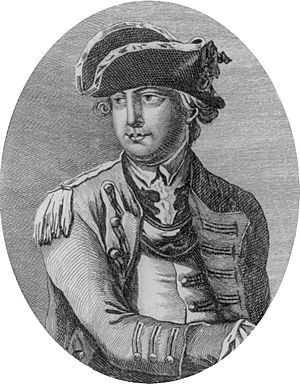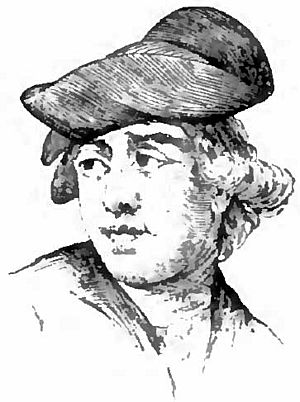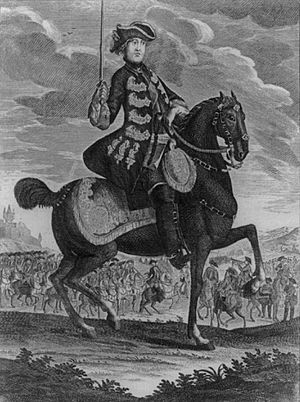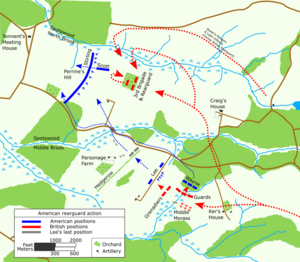Charles Lee (general) facts for kids
Quick facts for kids
Charles Lee
|
|
|---|---|
 |
|
| Born | 6 February 1732 [O.S. 26 January 1731] Darnhall, Cheshire, England |
| Died | 2 October 1782 (aged 50) Philadelphia, Pennsylvania, U.S. |
| Buried | |
| Allegiance | |
| Service/ |
|
| Years of service | British Army: 1747–1763 Continental Army: 1775–1780 |
| Rank | British Army: Lieutenant Colonel Polish Army: Major General |
| Unit | 44th Foot, 103rd Foot |
| Commands held | Southern Department of the Continental Army |
| Battles/wars | |
| Signature | |
Charles Lee (born February 6, 1732 – died October 2, 1782) was an English-born military officer. He became a general in the Continental Army during the American Revolutionary War. Before that, he served in the British Army during the Seven Years' War.
After the Seven Years' War, Lee left the British Army. He then served for a time in the Polish army under King Stanislaus II Augustus.
In 1773, Lee moved to North America and bought land in Virginia. When the American War of Independence began in 1775, he joined the rebel forces. Lee hoped to become the leader of the Continental Army. However, George Washington was chosen for that important role instead.
In 1776, troops under Lee's command successfully stopped a British attempt to capture Charleston, South Carolina. This made him very popular. Later that year, British soldiers captured him. He was held as a prisoner until 1778. During the Battle of Monmouth that same year, Lee led an attack that did not go well. He was later put on trial by the army and his military career ended. He died in Philadelphia in 1782.
Contents
Early Life and Family
Charles Lee was born on February 6, 1732, in Darnhall, Cheshire, England. His father was Major General John Lee. His mother was Isabella Bunbury. Charles had a sister named Sidney Lee, who was four years older and lived to adulthood.
Like his mother, Lee had a strong personality and often felt unwell. He suffered from conditions like rheumatism and gout. Because of this, he often visited places known for their healing waters. He was taught at home by tutors. Later, he went to grammar schools in England and a private school in Switzerland. Lee became very good at several languages, including Latin, Greek, and French.
When he was 15, in 1747, his father bought him a position as an ensign in the 44th Foot regiment. Lee was known for spending a lot of money. This often led to him having money problems throughout his life.
Military Career Before the Revolution
Fighting in North America
After finishing school, Lee joined his regiment in Ireland. In 1751, he became a lieutenant. In 1754, his regiment was sent to North America. They fought in the French and Indian War, which was part of the larger Seven Years' War.
Lee was with General Edward Braddock when his forces were defeated in 1755. During his time in America, Lee married the daughter of a Mohawk chief. They had twin children. The Mohawk people, who were allies of the English, called Lee Ounewaterika, which means "Boiling Water."
In 1756, Lee became a Captain. He took part in an expedition against the French fortress of Louisbourg in 1757. In 1758, he was hurt during an attack on Fort Ticonderoga. After he recovered, he helped capture Fort Niagara in 1759 and Montreal in 1760. These victories ended the war in North America.
Service in Portugal and Poland
Lee then returned to Europe. He joined the 103rd Foot regiment as a major. He also served as a lieutenant colonel in the Portuguese army. He fought against the Spanish during their invasion of Portugal in 1762. He showed great bravery at the Battle of Vila Velha.
In 1763, Lee returned to England after the Seven Years' War ended. His regiment was disbanded, and he was retired with half pay. In 1772, he was promoted to lieutenant colonel, even though he was not actively serving.
In 1765, Lee worked for King Stanislaus II of Poland. He had many adventures during this time. He returned to England but could not get a promotion in the British Army. So, in 1769, he went back to Poland. He then saw action in the Russo-Turkish War.
Return to America
When Lee returned to England, he felt sympathy for the American colonists. They were having disagreements with Britain. In 1773, he moved to the colonies. He bought an estate in what is now West Virginia. This was near his friend Horatio Gates, whom he had served with before.
Lee spent ten months traveling through the colonies. He met many American patriots and learned about their cause.
American Revolution Service
Joining the Continental Army
Many people at the Second Continental Congress thought Charles Lee was the most skilled person to lead the Continental Army. However, the job was given to George Washington. Lee understood why they chose an American-born leader. But he expected to be the second-in-command. He was disappointed when that role went to Artemas Ward. Lee was made a Major General, third in command. In 1776, he became second-in-command when Ward left due to illness.
Southern Commander
In 1776, Lee was made the first commander of the Southern Department. He held this position for six months. During this time, the British sent an army to capture Charleston, South Carolina. Lee was in charge of preparing the city's defenses.
Fort Sullivan was a fort built from strong palmetto logs. Lee ordered his troops to leave the fort, believing it would not last long. However, Governor John Rutledge told Colonel William Moultrie to hold the fort. The soft palmetto logs surprisingly bounced off the British cannonballs. The British attack on Sullivan's Island failed, and they gave up trying to take the city. Lee was called the "hero of Charleston," though some accounts say others deserved more credit.
New York and Capture
After a British victory at Fort Washington in November 1776, Lee openly criticized Washington. Lee believed Washington's delay in leaving the fort caused the loss. As Washington's army retreated across New Jersey, he asked Lee to join him. Lee's progress was slow.
On December 12, 1776, British troops captured Lee in New Jersey. He was writing a letter complaining about Washington at the time. He was held as a prisoner by the British until 1778.
Battle of Monmouth
Lee was released in April 1778 as part of a prisoner exchange. Washington welcomed him back. Lee was not aware of the changes that had happened in the army while he was captured. He also did not know about a possible plot to replace Washington. Lee felt that Washington was not fit to command.
Lee wanted to be promoted to lieutenant general. He also suggested a new plan for the army to Congress, which was different from Washington's ideas. Lee believed the American army should avoid big battles. He thought they should use a defensive strategy, wearing down the enemy with small attacks.
In June, the British army was moving through New Jersey. Washington held meetings with his generals to decide what to do. Most generals agreed to avoid a major battle. Lee strongly argued that a big battle would be a mistake. He thought the Continental Army was not strong enough to fight the British Army head-on.
Washington decided to launch a limited attack. He offered Lee command of the leading group of about 4,500 soldiers. Lee first refused, saying the force was too small for his rank. Washington then gave the command to Major General Marquis de Lafayette. Later, Lee changed his mind, and Washington sent him to take over from Lafayette.
Lee took command on June 27, 1778. The next day, June 28, Lee led his troops towards the British. He found the British rearguard, which he thought had about 2,000 soldiers. He ordered some of his men to hold the British in place. He planned to lead the rest of his troops around the British side. However, he did not tell his other officers about his plan.
The British commander, General Henry Clinton, ordered his main forces to return. Lee became worried that his own troops would be surrounded. Some of his units began to pull back without orders. Lee realized he was losing control. His force was now smaller, and he knew his plan to surround the British was over. He decided to order a general retreat to keep his soldiers safe.
The retreat was mostly orderly, and the Americans did not lose many soldiers. Lee thought he had done a good job retreating under fire. However, he failed to keep Washington informed.
Washington arrived on the battlefield and was surprised to see his troops retreating. He met Lee, who was trying to organize his men. Washington asked Lee why there was such "disorder and confusion." Lee tried to explain, blaming bad information and other officers for pulling back. He reminded Washington that he had been against the attack in the first place. Washington was not convinced and rode off to organize the battle himself. Lee felt he had been removed from command.
Washington quickly rallied the troops and set up defenses. He then gave Lee a choice: either stay and command the rearguard, or move back and organize defenses on another hill. Lee chose to command the rearguard. He fought the British counter-attack for about thirty minutes. This gave Washington enough time to get the main army ready. Lee was one of the last American officers to cross the bridge. Later, he was relieved of command.
Court-Martial and End of Service
After the battle, some of Washington's officers blamed Lee. Lee wrote a letter to Washington, complaining and saying Washington had been unfair. Washington replied that Lee's letter was "highly improper" and ordered an official investigation into Lee's actions. Lee then demanded a court-martial, which is a military trial.
The trial began on July 4, 1778. Lee faced three charges:
- Disobeying orders by not attacking as instructed.
- Conducting an "unnecessary, disorderly, and shameful retreat."
- Being disrespectful to the commander-in-chief.
The trial ended on August 12, 1778. Lee defended himself well, but he made it a personal fight against Washington. He called Washington's official report a "most abominable lie." He also tried to say his retreat was a clever move to trick the British. Washington stayed out of the arguments. However, his supporters painted Lee as a traitor.
Lee was found guilty on all three charges. The court removed the word "shameful" from the second charge and said the retreat was only "disorderly" in a few cases. Lee was suspended from the army for one year. This was a light punishment, which some saw as a sign that he was mostly innocent, except for being disrespectful.
Lee continued to argue his case and complain about Washington. This led to a duel with one of Washington's aides, John Laurens, where Lee was wounded. In 1780, Lee sent a letter to Congress that was so poorly received that they ended his service with the army.
Later Life and Legacy
After leaving the army, Lee moved to his property called Prato Rio in the Shenandoah Valley. He raised horses and dogs there. However, he had many debts again. His advisors told him to sell his property. By 1780, Lee was often sick with gout and had a chronic cough.
He traveled to several cities, including Philadelphia, to sell his property. While in Philadelphia, he became very ill with a fever and died on October 2, 1782. Even though his will said he did not want to be buried near a church, he was buried in the churchyard of Christ Church, Philadelphia after a military escort and a short service. Lee left his property to his sister, Sidney Lee.
Lee's last home, Prato Rio, still stands today and is a historical site. Fort Lee, New Jersey, was named after him during his lifetime. Other places like Lee, Massachusetts, Lee, New Hampshire, and Leetown, West Virginia, were also named in his honor.
In the 1850s, a document written by Lee in 1777 was found. It was written while he was a British prisoner of war. In it, he suggested a plan for the British to defeat the American rebellion. This discovery led many historians to view Lee as a traitor for many years. However, most modern historians do not believe Lee was guilty of treason.
Images for kids
See also
 In Spanish: Charles Lee para niños
In Spanish: Charles Lee para niños





